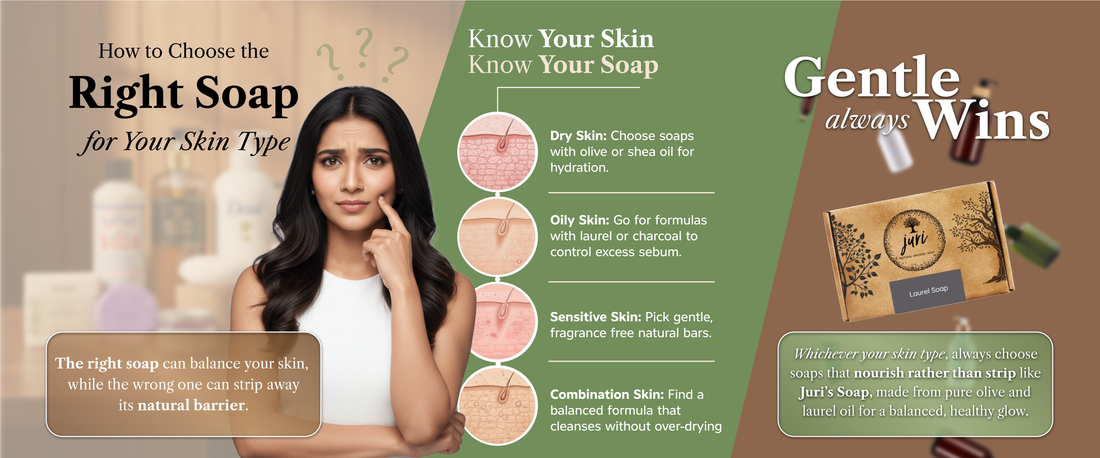
How to Choose the Right Soap for Your Skin Type
Table of Contents
Introduction
Selecting the appropriate cleanser for your skin is one of the most fundamental decisions in any skincare routine, yet it remains surprisingly misunderstood. The skin barrier, composed of lipids, proteins, and natural moisturizing factors, requires careful balance to maintain optimal health. Using the wrong soap can disrupt this delicate ecosystem, leading to dryness, irritation, breakouts, or excess oil production. Understanding your skin type and matching it with compatible ingredients is essential for long-term skin wellness.
This comprehensive guide examines the science behind different skin types and provides evidence-based recommendations for choosing natural soap formulations. Whether you have oily, dry, sensitive, combination, or acne-prone skin, the right cleanser can transform your complexion while respecting your skin's natural biology. By understanding the functional mechanisms of key ingredients, you can make informed decisions that support healthy, radiant skin.
Cultural and Historical Foundation
The tradition of natural soap making stretches back thousands of years, with ancient civilizations recognizing the cleansing and therapeutic properties of plant-based ingredients. Mediterranean cultures perfected the art of olive oil soap production, creating gentle formulations that preserved the skin's natural moisture. Middle Eastern traditions incorporated laurel oil for its purifying qualities, while Asian practices emphasized botanical extracts for skin harmony.
Modern natural skincare builds upon this ancestral wisdom, combining time-tested ingredients with contemporary dermatological research. The shift toward natural beauty reflects growing awareness that synthetic detergents and harsh surfactants can compromise skin health over time. Traditional soap making methods, particularly cold-process techniques, preserve the beneficial properties of oils and plant compounds that would otherwise be destroyed by high-heat manufacturing.
Common Skin Problems Juri Soap Addresses
Each skin type presents unique challenges that require targeted solutions. Oily skin struggles with excess sebum production, enlarged pores, and shine, often resulting from hormonal factors or overactive sebaceous glands. The key is balancing oil control without triggering rebound oil production through over-cleansing.
Dry skin lacks sufficient lipids in the skin barrier, leading to tightness, flaking, and increased sensitivity. Environmental factors, aging, and harsh cleansers exacerbate this condition. Sensitive skin reacts easily to irritants, manifesting as redness, burning, or inflammation. This often involves a compromised skin barrier or underlying conditions like rosacea.
Combination skin features both oily and dry zones, typically with an oily T-zone and drier cheeks. This requires balanced formulations that address multiple needs simultaneously. Acne-prone skin battles bacterial overgrowth, inflammation, and clogged pores, necessitating ingredients that purify without causing excessive dryness or irritation.
Detailed Ingredient Comparison
| Skin Type | Key Ingredients | Primary Benefits | Juri Soap Variants |
|---|---|---|---|
| Oily | Activated charcoal, tea tree oil, clay minerals | Deep pore cleansing, sebum regulation, detoxification | Charcoal Detox (upcoming) |
| Dry | Olive oil, shea butter, glycerin, colloidal oatmeal | Intense hydration, barrier repair, moisture retention | Oat Soothing (upcoming) |
| Sensitive | Colloidal oatmeal, chamomile, calendula, allantoin | Anti-inflammatory, barrier protection, calming | Oat Soothing (upcoming) |
| Combination | Laurel oil, jojoba oil, aloe vera, green tea extract | Balanced cleansing, pH regulation, antioxidant protection | Classic Laurel Formula |
| Acne-Prone | Laurel oil, turmeric, neem, salicylic acid derivatives | Antibacterial action, inflammation reduction, pore clarification | Turmeric Brightening (upcoming) |
Juri Soap Advantage
The Juri Soap collection distinguishes itself through a commitment to authentic cold-process manufacturing, which preserves the integrity of natural oils and botanical compounds. Unlike commercial soaps that strip the skin with synthetic detergents, Juri Soap formulations maintain skin pH balance while providing effective cleansing.
Each variant is developed with specific skin needs in mind, utilizing high concentrations of active ingredients rather than trace amounts. The classic laurel formula combines olive oil and laurel oil in carefully calibrated ratios, offering antibacterial properties without disruption to the skin microbiome. Future releases will expand this foundation with targeted solutions.
The upcoming Turmeric Brightening variant will harness curcumin's powerful anti-inflammatory and antioxidant properties, addressing hyperpigmentation and uneven tone. Charcoal Detox will incorporate activated bamboo charcoal for deep pore purification and toxin absorption. Oat Soothing will feature colloidal oatmeal for its clinically proven ability to reduce irritation and strengthen the skin barrier.
Scientific and Functional Mechanisms
Understanding how natural skincare ingredients interact with skin biology reveals why certain formulations work better for specific conditions. Olive oil, rich in oleic acid and polyphenols, penetrates the stratum corneum to deliver antioxidants while forming a protective lipid layer. Its fatty acid profile closely mimics sebum composition, making it compatible with all skin types.
Laurel oil contains lauric acid, a medium-chain fatty acid with documented antimicrobial activity against Cutibacterium acnes, the primary bacteria implicated in acne formation. Research demonstrates lauric acid's ability to reduce inflammatory lesions without the irritation associated with conventional acne treatments. This makes laurel oil particularly valuable for acne-prone and combination skin.
Activated charcoal functions through adsorption, binding to impurities, excess oil, and environmental pollutants on the skin surface. Its porous structure provides exceptional surface area for trapping toxins, making it ideal for oily and congested skin. Turmeric's curcuminoids inhibit melanin synthesis and reduce inflammatory cytokines, addressing both pigmentation and redness.
Application and Daily Ritual
Proper cleansing technique maximizes the benefits of natural soap while minimizing potential irritation. Begin with lukewarm water, as hot water can strip protective oils and damage the skin barrier. Create a rich lather by rubbing the soap between wet hands or using a cleansing cloth for gentle exfoliation.
Apply the lather to damp skin using circular motions, focusing on areas prone to congestion like the T-zone for combination skin or the entire face for oily types. Allow the soap to remain on the skin for 30 to 60 seconds, giving active ingredients time to work. This brief contact period is sufficient for cleansing without over-drying.
Rinse thoroughly with cool water to close pores and remove all soap residue. Pat the skin dry with a clean towel rather than rubbing, which can cause irritation. For optimal results, cleanse twice daily for oily and acne-prone skin, once daily for dry and sensitive types. Those exploring natural beauty alternatives often find that less frequent cleansing allows the skin microbiome to stabilize.
Results Timeline and Expectations
Skin improvement follows a predictable timeline when using appropriate cleansing products. Initial changes appear within one to two weeks as the skin adjusts to gentler cleansing. Oily skin typically shows reduced shine and smaller pores as sebum production normalizes. Dry skin experiences less tightness and flaking as the barrier strengthens.
By four to six weeks, more significant transformations become evident. Acne-prone skin sees reduced breakouts and inflammation as bacterial populations balance. Sensitive skin develops increased tolerance and reduced reactivity. Combination skin achieves better overall balance with less pronounced oily and dry zones.
Long-term use, extending beyond eight weeks, brings cumulative benefits. The skin barrier becomes more resilient, better able to retain moisture and resist environmental stressors. Texture improves as cell turnover normalizes. For those interested in documenting their journey, the Juri Soap Journal offers insights and community experiences.
Advanced Tips and Pairings
Maximizing the benefits of natural soap involves strategic pairing with complementary skincare practices. For oily skin, follow cleansing with a lightweight, water-based moisturizer containing hyaluronic acid or niacinamide. These ingredients hydrate without adding oil while supporting barrier function.
Dry skin requires richer emollients applied immediately after cleansing to seal in moisture. Look for products containing ceramides, squalane, or plant oils that reinforce the lipid barrier. A humidifier in dry climates provides additional environmental support.
Sensitive skin benefits from minimal product layering and avoiding potential irritants like fragrances and essential oils in subsequent products. Consider implementing a skin cycling routine that alternates active ingredients with recovery periods, allowing the skin to repair between treatments.
Frequently Asked Questions
How often should I change my soap based on seasonal skin changes?
Skin needs shift with climate variations, requiring adjustments two to three times annually. Winter typically demands more moisturizing formulations as indoor heating and cold air deplete skin hydration. Summer heat may necessitate lighter, more purifying options to manage increased sebum production. Monitor your skin's response and switch formulas when you notice persistent tightness, excess oil, or irritation lasting more than a week.
Can natural soap help with hormonal acne?
While natural soap cannot address the internal hormonal factors driving acne, it can significantly reduce surface bacteria and inflammation that exacerbate breakouts. Laurel oil's antimicrobial properties specifically target acne bacteria, while gentle cleansing prevents the barrier damage that makes skin more vulnerable to infection. Combine appropriate cleansing with internal approaches like balanced nutrition and stress management for comprehensive results.
Why does my skin feel tight after cleansing?
Tightness indicates excessive removal of natural oils and disruption of the skin barrier. This occurs with alkaline soaps, harsh surfactants, or over-cleansing. Switch to a more moisturizing formula with higher olive oil content, reduce cleansing frequency, and ensure you are applying moisturizer within three minutes of cleansing when skin is still slightly damp for optimal absorption.
How long does natural soap last compared to commercial cleansers?
A properly stored natural soap bar typically lasts four to six weeks with daily use, comparable to or exceeding liquid cleansers. Extend longevity by keeping the bar dry between uses on a well-draining soap dish and away from direct water spray. The concentrated nature of bar soap means less product is needed per use compared to liquid formulations.
Is it necessary to use different soaps for face and body?
While not strictly necessary, facial skin is thinner and more sensitive than body skin, potentially requiring gentler formulations. Body skin tolerates stronger cleansing and exfoliation. If using the same soap for both areas, choose a formula appropriate for your face, as this will be safe for your body. Those with very dry or sensitive skin may benefit from dedicated facial and body products optimized for each area's specific needs.
Conclusion
Choosing the right soap for your skin type represents a foundational investment in long-term skin health. By understanding your skin's unique characteristics and matching them with scientifically supported natural ingredients, you create the optimal environment for a healthy, balanced complexion. The shift toward natural skincare is not merely a trend but a return to formulations that work in harmony with skin biology rather than against it.
Juri Soap's commitment to authentic manufacturing methods and high-quality ingredients provides solutions for every skin concern. Whether addressing excess oil, dryness, sensitivity, or acne, the right formulation can transform your daily cleansing ritual from a mundane task into a therapeutic practice that supports overall skin wellness.
Disclaimer: This article is for informational purposes only and does not constitute medical advice. Consult with a qualified dermatologist or healthcare professional before making any changes to your skincare regimen.
Sources
- Lin, T. K., Zhong, L., & Santiago, J. L. (2018). Anti-inflammatory and skin barrier repair effects of topical application of some plant oils. International Journal of Molecular Sciences, 19(1), 70.
- Nakatsuji, T., Kao, M. C., Fang, J. Y., et al. (2009). Antimicrobial property of lauric acid against Propionibacterium acnes: its therapeutic potential for inflammatory acne vulgaris. Journal of Investigative Dermatology, 129(10), 2480-2488.
- Reynertson, K. A., Garay, M., Nebus, J., et al. (2015). Anti-inflammatory activities of colloidal oatmeal contribute to the effectiveness of oats in treatment of itch associated with dry, irritated skin. Journal of Drugs in Dermatology, 14(1), 43-48.
- Vaughn, A. R., Branum, A., & Sivamani, R. K. (2016). Effects of turmeric (Curcuma longa) on skin health: A systematic review of the clinical evidence. Phytotherapy Research, 30(8), 1243-1264.
- Proksch, E., Brandner, J. M., & Jensen, J. M. (2008). The skin: an indispensable barrier. Experimental Dermatology, 17(12), 1063-1072.
